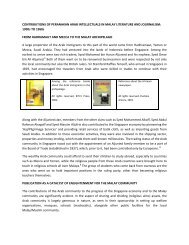The Transmission and Impact of the Hadhrami and Persian ... - Rihlah
The Transmission and Impact of the Hadhrami and Persian ... - Rihlah
The Transmission and Impact of the Hadhrami and Persian ... - Rihlah
You also want an ePaper? Increase the reach of your titles
YUMPU automatically turns print PDFs into web optimized ePapers that Google loves.
An instrument <strong>of</strong> this kind has also been found in Sulawesi but it has 6 double-strung<br />
strings. A specimen <strong>of</strong> this type <strong>of</strong> gambus from Sulawesi, shown in Plate (ix), was also<br />
found in <strong>the</strong> Musée de l’Homme in France. 38<br />
Plate (ix) Gambusu<br />
Musée de l’Homme (France)<br />
Evidence pointing towards <strong>the</strong> contribution <strong>of</strong> <strong>the</strong> Muslims from Persia <strong>and</strong> Arabia in<br />
<strong>the</strong> transmission <strong>of</strong> <strong>the</strong> <strong>Hadhrami</strong>/<strong>Persian</strong> lute-type instruments to <strong>the</strong> Malay Archipelago is<br />
substantial <strong>and</strong> conclusive. <strong>The</strong> use <strong>of</strong> terms such as: Hadhramaut, Yemen, gambus, zapin,<br />
sharah, samra, marwas, Arab, <strong>and</strong> Hijaz, could be plausible admission <strong>of</strong> <strong>Hadhrami</strong><br />
influences <strong>and</strong> transmission <strong>of</strong> lute instruments from Yemen ra<strong>the</strong>r than Persia. 39 With <strong>the</strong><br />
Islamization <strong>of</strong> <strong>the</strong> Malay Archipelago in <strong>the</strong> 15th century, many Muslim Arab traders<br />
established strong trade links with <strong>the</strong>se areas. However, I have not come across <strong>the</strong> word<br />
“qanbus” in any primary text, although <strong>the</strong> word “barbat” has been used frequently to<br />
describe <strong>the</strong> <strong>Persian</strong> lute. <strong>The</strong>re is also concrete historical evidence that supports <strong>the</strong> presence<br />
38 I am grateful to Lucie Rault at Musée de l’Homme (France) who made all <strong>the</strong> necessary arrangements for me<br />
to make a detailed study <strong>of</strong> <strong>the</strong> instrument. This instrument was labelled as “gambusu” from Sulawesi, in<br />
Indonesia.<br />
18




